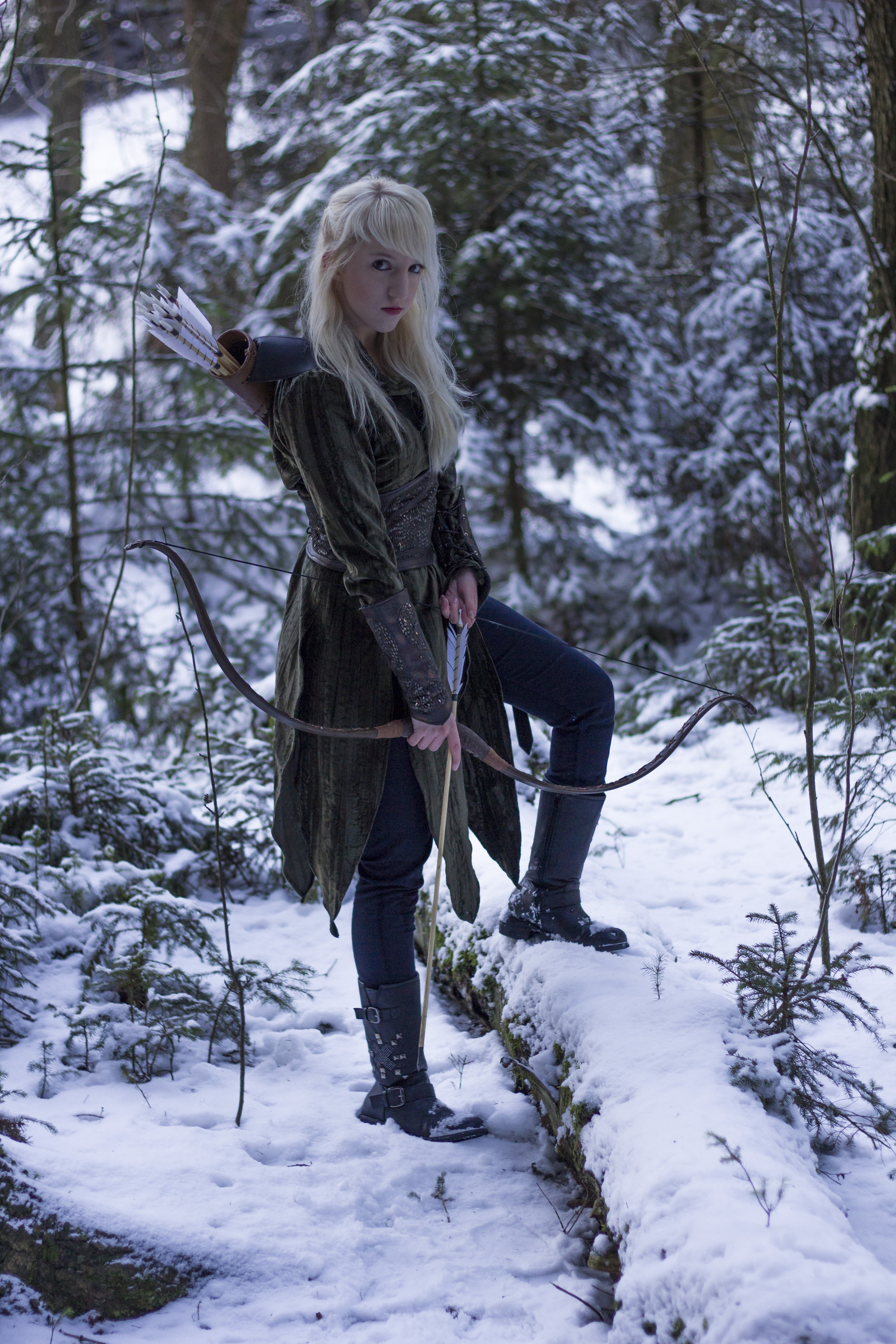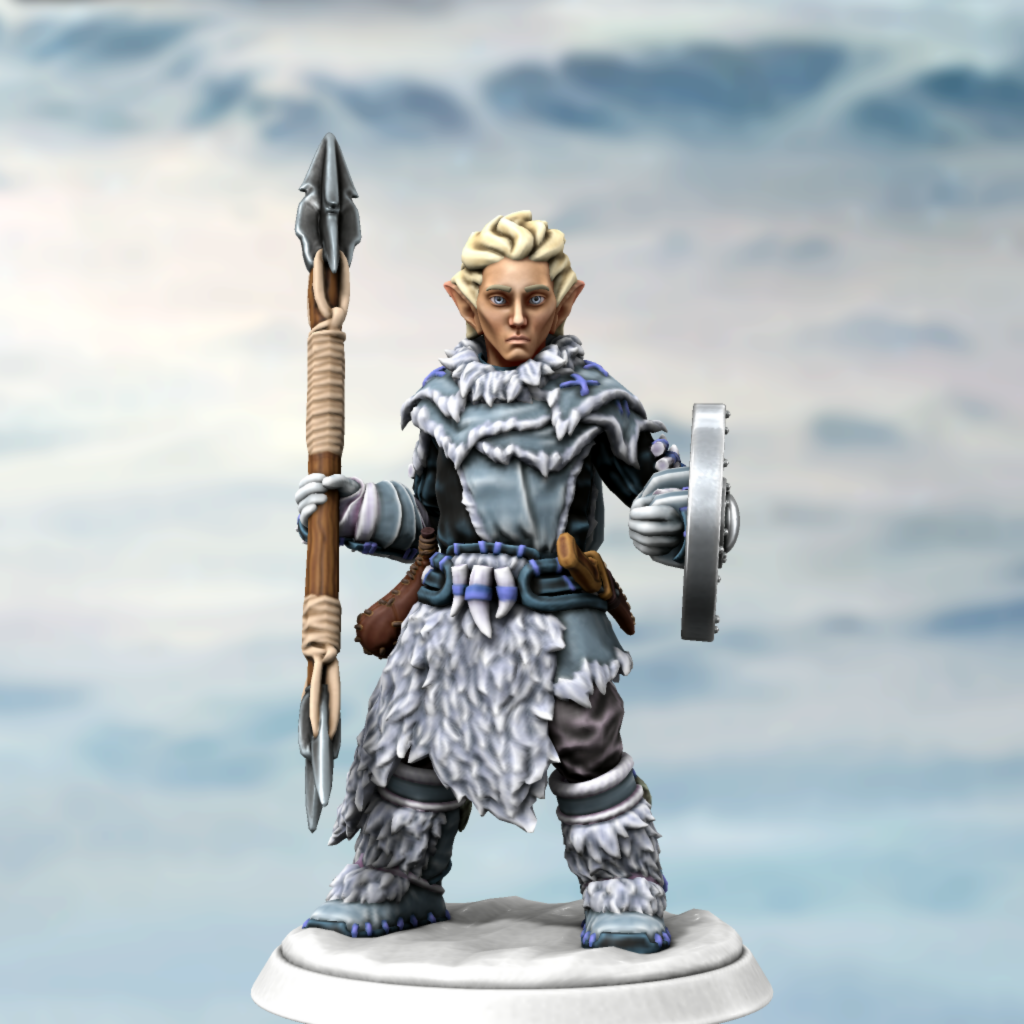taiga elves
The taiga elves are an offshoot of the wood elves of Nation of Codenya. While the wood elves have many clans and tribes differentiating themselves from mainstream Codenya society in some way, taiga elves are the most distinct group because they very rarely intermarry or mix with other wood elves in a lasting fashion.
Appropriate to their name, the taiga elves dwell primarily in the colder forests to the north of Codenya where the forest eventually gives way to the The Great Colassian Tundra. While they frequently stick to the taiga, they do not shun roaming the tundra.
They are bound by treaty and tradition to the Nation of Codenya, but the taiga elves keep their distance. wood elves are known to outsiders as being independent, stubborn, and isolationist. Taiga elves come across as independent, stubborn, and isolationist even to other wood elves. Unless there is a war or other unusual event prompting the activation of their treaty obligations, the taiga elves only meet with the other wood elves for trade and joint religious and cultural ceremonies two or three times a year.
This isolationism permeates their culture beyond their dealings with other elves. Codenya is only approximately 70% elven. They have many allies that are formally part of the nation including forest gnomes and Codenya kalazotz among many others, but taiga elves do not mingle with these groups as much. When they meet, they are friendly enough, but prefer to distance interactions through a layer of polite formalities.
Between their preference for cold weather climates and their highly nomadic life styles, taiga elves are probably the most airy elves in all of Scarterra. Many have a pinch of earthy traits or a splash of water traits, but it's all but unheard of for one of them to show even a tiny ember of fiery traits. This means they are taller and leaner than most other wood elves and they are a lot lighter of skin tone and hair color.
Most wood elves live by a mix of low impact farming and hunting and gathering. The Taiga elves cultivate a few hardy cold weather herbs but they live almost entirely on hunting and gathering. While their population is small, Taiga Elves are a lot more nomadic than average wood elves. They like trees and they like the taiga, but they could just as easily be called "tundra elves". In a typical year, taiga elves cover three to four times the total miles traveled by southern wood elves.
Culture
Major language groups and dialects
They speak of course Elven. They have a tendency to speak slowly and often couch their words in riddles and metaphors. It is believed they talk more simply amongst themselves but they like to appear as mysterious among outsiders as an inside joke.
Culture and cultural heritage
Some mainstream wood elves admire the taiga elves' spirituality, and other wood elves call the taiga elves air headed naval gazers.
Taiga elves like riddles, meditation, and seeking spiritual signs. They favor this cerebral personal approach to the Nine, the afterlife, their ancestors, the spirits, and the world as a whole as opposed to relying on formal dogma. This is not an uncommon outlook for wood elves in general but taiga elves tend to take this to an extreme.
Average technological level
Taiga elves might be somewhat distant from other wood elves of Codenya, but they are not removed from them. They have access to the same collective lore that the rest of the wood elves enjoy. What the taiga elves cannot make for themselves, they can barter for from other wood elves.
Common Dress code
Taiga elves dress practically for the harsh climates they dwell in. They not only want to dress warmly, but they prefer white clothing in the winter and browns in the summer for camouflage.
They do have a creative side and like to express themselves subtly in their dress. They wear a lot of jewelry made of simple inexpensive materials but lovingly crafted with intricate workmanship. Their knotwork is considered especially beautiful and is often sought after by other wood elves.
Art & Architecture
Besides their jewelry and good luck trinkets, the Taiga elves do not have much physical art. Their architecture is primarily tents and igloos erected temporarily.
The Taiga elves primary form of artistic expression is via music. Singing and percussion instruments are especially appreciated.
Common Customs, traditions and rituals
Taiga elves are technically fully polytheist but they usually venerate Korus above all the rest of the Nine. The rest tend to get almost token worship outside of a few holidays, many of which overlap with mainstream wood elf observances. Very few taiga elves ever become priests or theurgists to deities other than Korus.
While they honor Korus, they value balance and completeness. They do not shun any of the Nine outright, even the typically unpopular ones.
Birth & Baptismal Rites
Taiga elves wait twenty-seven days after birth before observing a child's Naming Day. This is marked with a simple ceremony usually presided by priests of Korus, but it can be done by a lay person in a pinch. Their parents or guardians typically create a knotwork spelling out the child's name. This is carried with the child until he or she grows up in which case the knotwork is bestowed to an elder family memory at the end of the child's coming of age rite.
When a taiga elf turns nine years old, they have a second Naming Day ceremony that is more elaborate involving formal rituals followed by an informal party usually involving lots of extended family.
An elf child at nine years old is developmentally equal to a human at five, roughly, but the elf will usually ceremonially dye his or her personal knotwork at the start of this second ceremony.
Coming of Age Rites
Adolescent boys and girls go through a vision quest under the supervision of older family members and/or priests.
Tests vary but they usually involve physical and emotional hardship. The hardship is mostly symbolic. There are always adults standing by, so it's rare for young elf to die during their rite of passage into adulthood, but elves will find themselves judged for their rest of their lives based on how well they cope with the hardships given.
It's considered especially auspicious to have a spiritually significant encounter with an animal. It's possible to find a spirit animal earlier or later in life too. Taiga elves with spirit animals will usually display the iconography of their spirit animal almost constantly.
While not every elf with a spirit animal can manipulate magical forces and not every wielder of supernatural power has a spiritual animal, they are commonly linked with spirit loas, mages, and theurgists all uses their spirit animal as a focus.
Not every elf receives a spirit animal, but every elf does make a knotwork themselves to mark their rise to adulthood. While not required (its is possible for an elf to lose his or her personal knotwork and it is not explicitly forbidden for a taiga elf to marry another elf), it is very common for married couples to swap their knotworks upon their marriage ceremony
Funerary and Memorial customs
Taiga elves will usually cremate their dead, time and circumstances permitting.
Given the harsh natures of their existence, a taiga elves cannot always recover the body and have the means to create a full funeral pyre. If this is the case, symbolic knotwork spelling the elf's name is burned instead. If they cannot burn their original knotwork, a new one can be made by a bereaved friend or relative.
taiga elf Rumspringas
Most wood elves take a Rumspringa to spend a few decades of their young adult lives exploring the outside world interacting with humans, dwarves, and other mortals outside their homeland. Only about a quarter of taiga elves choose to take a traditional twenty to thirty year Rumspringa. Some forgo the Rumspringa entirely. A majority of taiga elves go on an internal Rumspringa where they live among wood elves of the southern provinces of Codenya outside their taigas but still in the forests. This is about the only time most taiga elves will interact with the wood elves' traditional forest allies without all the formalities. These Rumspringas are often much shorter rarely encompassing much more than a single decade. A new informal tradition is to take a nine year Rumspringa beginning and ending on Korus' Zodiac year. This mini-Rumspringa is valued by both taiga elves and wood elves as a whole. Without this tradition, the taiga elves might have split off from the rest of Codenya entirely centuries ago.
Parent ethnicities
Encompassed species
Languages spoken
Related Locations



Comments